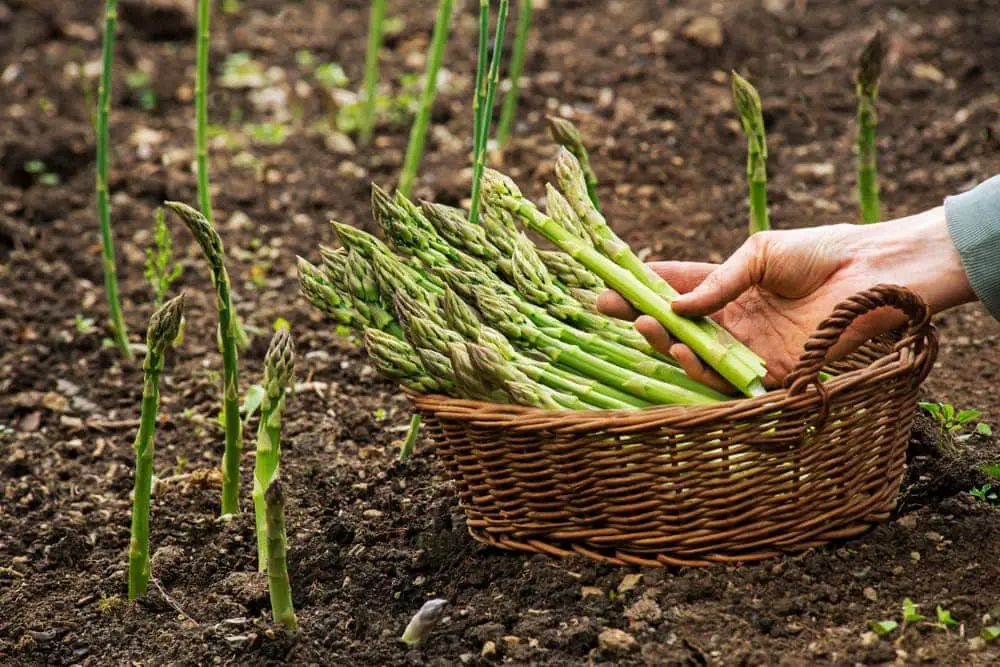Asparagus is a wonderful vegetable to grow in your home garden. It looks great and tastes great.
Its light leaves sway gently in the wind, and vegetable gardeners all over the world look forward to its spear-shaped shoots, which mean a good growing season.
But have you ever thought that the plants next to your asparagus can have a big effect on how much you get?
In vegetable gardening, this idea is at the heart of what is called “companion planting,” which can make all the difference in how well your asparagus grows.
This article will delve into the fascinating world of companion planting with asparagus, a method that has been used for hundreds of years and is based on a lot of experience.
We’ll talk about which vegetables grow well with asparagus and which ones don’t. We’ll also look at how strategically placing certain plants can attract good bugs, keep asparagus beetles away, and make sure you get a good harvest.
This guide will teach you how to get more asparagus from your garden, whether you’re planting in a big bed or a pot. It will also help your plants stay healthy for many years to come.
Asparagus is a popular vegetable that many home gardeners love to grow. With its delicious spears appearing in spring, asparagus brings anticipation and excitement to the gardening season.
However, many are unsure about what to plant alongside their asparagus for the best results. Understanding asparagus companion planting can optimize your garden’s productivity and beauty all season long.
In this article we’ll explore the best and worst companion plants for asparagus. We’ll also provide growing tips to help you cultivate thriving asparagus beds with healthy abundant harvests.
Why Companion Planting Matters
Companion planting is the practice of strategically planting certain crops together to maximize garden space and productivity. When done effectively, companion planting offers many benefits, including:
- Natural pest control – Some plants deter or trap pests reducing damage to your asparagus.
- Improving pollination – Plants that attract pollinators can increase fruit set for asparagus and other crops
- Enhancing flavor – Some companions influence flavor. For example, basil and tomatoes are said to boost each other’s taste when planted together.
- Promoting growth – Certain plants provide shade, nitrogen-fixing, or other benefits to asparagus, improving its productivity.
- Weed suppression – Low-growing companions act as living mulch, reducing weeds.
- Efficient use of space – Combining plants with different growth habits optimizes your garden real estate.
Taking time to understand asparagus companions can transform your garden’s health and bounty.
Best Companion Plants for Asparagus
Here are some excellent options for asparagus companion planting:
1. Tomatoes
Tomatoes are among the top companion plants for asparagus. They help repel the destructive asparagus beetle pest. Meanwhile, asparagus can protect tomatoes from nematodes.
2. Basil
The scent of basil confuses asparagus beetles, deterring them from your asparagus. Basil also attracts beneficial pollinators.
3. Parsley and Dill
These herbs attract predatory insects that prey on asparagus beetles and other pests. Their aromas also help confuse pests.
4. Marigolds and Nasturtiums
These brightly colored flowers deter asparagus beetles with their vivid hues and strong fragrances. They also attract pollinators.
5. Strawberries
The low-growing strawberry plants provide living mulch around asparagus. Different harvest times prevent competition for nutrients.
6. Peas and Beans
Legumes fix nitrogen from the air into the soil, feeding nearby asparagus plants. They also suppress weeds.
7. Carrots and Radishes
These root crops don’t compete with asparagus for nutrients. Their foliage provides modest ground cover to retain moisture.
With thoughtful planning, these and other companion plants can improve the health and productivity of your asparagus significantly.
Worst Companion Plants for Asparagus
When companion planting, it’s also crucial to know which plants to avoid near asparagus:
- Onions, garlic, and leeks inhibit asparagus growth, likely by competing for nutrients.
- Potatoes are another heavy feeder. They may lead to nutrient deficiencies in asparagus.
- Beans (not peas) also suppress asparagus growth when planted in close proximity.
By steering clear of these unsuitable companions, you can prevent stunted growth or lower yields from your asparagus.
Growing Tips for Healthy, Productive Asparagus
Beyond companion planting, adopting these asparagus growing tips will give your plants the best chance of thriving:
- Select a sunny location. Asparagus needs at least 6-8 hours of direct sunlight daily.
- Prepare the soil thoroughly. Asparagus prefers nutrient-rich, well-draining soil. Incorporate compost and adjust pH to 6.5-7.
- Allow enough space. Give each asparagus crown 2-4 feet of space. Wider rows allow for companions.
- Water regularly. Water new plantings daily. Established asparagus needs about 1-2 inches weekly.
- Use raised beds. Asparagus grows best in raised beds that warm quickly and provide excellent drainage.
- Mulch generously. Apply 2-3 inches of organic mulch like wood chips or straw around plants to conserve moisture and suppress weeds.
- Fertilize each spring. Feed established asparagus beds with compost or nitrogen-rich fertilizer yearly.
With attention to sun, spacing, watering, and nutrition, your asparagus will thrive beautifully alongside its companion plants.
Start Planning Your Asparagus Companion Garden
By understanding the unique partnerships that exist between plants, we can create symbiotic growing environments where every plant contributes.
Tomatoes, basil, marigolds, strawberries, and other thoughtful companions can help asparagus grow strong and become more productive.
Meanwhile, be sure to avoid planting asparagus near potatoes, onions, beans, and other unsuitable neighbors.
Beyond smart companion planting, practices like preparing the soil, providing support, and maintaining proper care will ensure your asparagus remains healthy and abundant for years to come.
The world of companion planting opens up endless possibilities to grow food and flowers together in harmony. Let your imagination run wild as you discover how to maximize every square foot of your garden with asparagus and its ideal companions.

Spatial Efficiency and Crop Protection
Companion planting also optimizes garden space.
Plants that grow taller can provide shade for plants that grow shorter and are sensitive to the sun. Plants that grow outward can act as living mulch, keeping the soil moist and weeds down.
For instance, planting lettuce or strawberries, which do well in conditions similar to those of asparagus, can act as a ground cover to keep water from evaporating and stop weeds from growing.
By attracting beneficial insects, companion planting can also enhance pollination, crucial for many fruiting vegetables.
More diversity in your garden can also lead to a healthier and more resilient ecosystem.
With a mix of plants, pests are less likely to spread rapidly and cause significant damage.
When growing asparagus, using companion plants can help keep pests away, make better use of space, and even lead to a bigger harvest.
Hence, understanding the dynamics of asparagus companion planting is a significant step towards a flourishing garden.
To learn more about vegetable companion planting, check out my guides:
companion planting asparagus
FAQ
What is a cover crop for asparagus bed?
What is the best ground cover for asparagus?
What does asparagus repel?
- A Complete Guide to Caring for Yuki Cherry Blossom Shrub - January 23, 2025
- Identifying Red Hot Poker Seeds: What to Look For When Harvesting Torch Lily Pods - January 23, 2025
- A Complete Guide to Harvesting Evening Primrose Seeds - January 23, 2025
